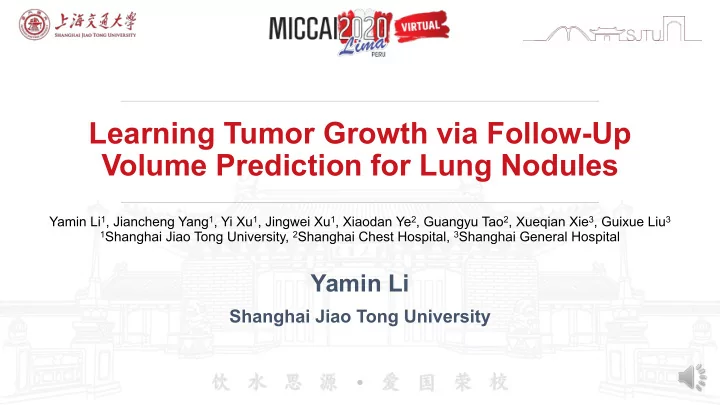

Learning Tumor Growth via Follow-Up Volume Prediction for Lung Nodules Yamin Li 1 , Jiancheng Yang 1 , Yi Xu 1 , Jingwei Xu 1 , Xiaodan Ye 2 , Guangyu Tao 2 , Xueqian Xie 3 , Guixue Liu 3 1 Shanghai Jiao Tong University, 2 Shanghai Chest Hospital, 3 Shanghai General Hospital Yamin Li Shanghai Jiao Tong University
Background Background: Help radiologists with lung nodule management l Ø Follow-up serves an important role in the management of pulmonary nodules for lung cancer. Ø Recent deep learning studies using convolutional neural networks (CNNs) to predict the malignancy score of nodules, only provides clinicians with black-box predictions and needs pathological labels. Ø Accurate prediction of tumor growth could help radiologists evaluate the risk of lung nodules without pathological examination and make clinical decision for each patient.
Task & Dataset Task: To predict future volume of a lung nodule given any time interval and a baseline volume. l Dataset: l Ø Cases with long-term follow-up and LDCT scans are extremely difficult to obtain. Ø Currently we have more than 300 pulmonary nodules and more than 700 follow-up pairs collected from Shanghai Chest Hospital and Shanghai General Hospital . Ø Each nodule has a pixel-level label annotated by professional radiologists. Ø All nodules of one patient are divided into the same subset while performing 5-fold cross-validation. 3 pairs Time point 1 Time point 2 Time point 3 Δ𝑢 ! Δ𝑢 " Δ𝑢 ! + Δ𝑢 "
Method Temporal Encoding:
Method
Results PSNR* means PSNR inside the nodule
Results
Results
Thanks for Listening!
Recommend
More recommend